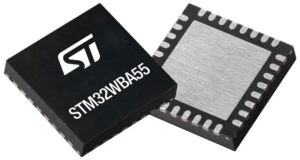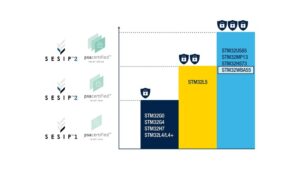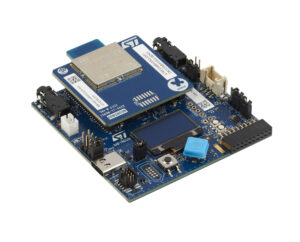Update, May 14, 2025
The STM32WBA5MMG, an ultra-low-power, small form factor, certified 2.4 GHz wireless module, is now available. It supports Bluetooth® LE, Zigbee® 3.0, OpenThread, as well as dynamic and static concurrent modes. Based on the STM32WBA55UG wireless microcontroller, its RF performance stands out due to its good receiver sensitivity (-97.5 dBm in IEEE 802.15.4 at 250 Kbit/s) and high output power signal (+10 dBm with 1 dB steps). It includes a fully integrated Bill of Materials (BOM), featuring 32 MHz and 32 kHz crystals, as well as integrated antenna matching with optional external antenna configurations.
The module is also compatible with 2-layer PCBs to help reduce costs, while its low-power features enable extended battery lifetime, even when using small coin-cell batteries. The fact that the STM32WBA5MMG is a module means that it requires no RF expertise. Hence, it’s the best way to speed up application development and to reduce the associated costs. The module is also a completely royalty-free protocol stack. The best way to test it is to try the B-WBA5M-WPAN expansion board, which utilizes an M.2 connector to enable developers to easily insert and remove it from their test platform.
Finally, the STM32WBA5x series of devices just officially received its SESIP Level 3 Certification, further solidifying STM32 devices as consistently capable of one of the highest levels of security conferred to general-purpose MCUs.
Original publication, March 19, 2024
The STM32WBA54 and STM32WBA55 are the first members of the STM32WBA series to support multiple wireless protocols besides Bluetooth 5.4 and the first to support Bluetooth Low Energy (BLE) audio. Put simply, they take cues from the STM32WBA52, announced last year but add support for OpenThread, Zigbee, and a concurrent mode to open the door to vastly more applications. The new MCUs could also fit in earbuds and other personal devices, thanks to their audio capabilities. The only difference between the STM32WBA54 and the STM32WBA55 is that the former only provides an LDO, while the latter has an LDO and an SMPS.
What’s new in the STM32WBA54 and STM32WBA55
Enhanced wireless performance for greater user experience

While Bluetooth remains highly popular, other protocols continue to thrive. For example, technologies like OpenThread and Zigbee address a wider range of industrial and smart home applications. Additionally, an increasing number of companies work on a custom IEEE 802.15.4 protocol for regulatory, security, or competitive reasons. Consequently, it is critical to ensure developers get the flexibility they need to face this new wireless landscape. Teams must anticipate the use of a greater number of protocols. Having one device supporting them means qualifying only one part number, which means integrators have far more flexibility while improving their time to market.
The STM32WBA54 and STM32WBA55 go even one step further, thanks to their concurrent mode that supports multiple protocols simultaneously. In practical terms, developers can run a Bluetooth Low Energy and a Zigbee or Thread stack using only one radio. Consequently, a smart appliance could use Zigbee to talk to other end nodes in the house while using BLE to communicate with the mobile application on the user’s phone. This is possible thanks to the STM32WB radio time-sharing manager (RTSM) that dynamically switches between stacks so they can run in parallel (See Application Note AN5613).
Bluetooth audio streaming for greater accessibility
The STM32WBA54 and STM32WBA55 are our first BLE 5.4 devices capable of audio streaming. By adding a serial interface for audio, we can support streaming features like Auracast broadcasting, which significantly impacts assistive devices like hearing aids. For instance, one transmitter can send an audio signal to all Bluetooth-compatible receivers at the same time instead of having to establish a point-to-point connection. As a result, a train station could broadcast information to multiple assistive devices simultaneously and with greater ease of use. Consumers simply search for supported broadcasts with a mobile application, similar to searching for a Wi-Fi network, and receive the audio stream.
What’s the shared DNA with the STM32WBA52
Security

As the nomenclature implies, the STM32WBA54 and STM32WBA55 share a lot of their DNA with the STM32WBA52 that we released in 2023. Among other things, there’s the same Cortex-M33 core running at 100 MHz. Consequently, the three devices have some common key features, such as hardware and software protections enabling all devices to target a SESIP Level 3 Certification. Developers also get features like TrustZone, Trusted Firmware, Secure Boot, Secure Debug, and more to implement robust applications and meet upcoming security challenges. As governments impose new requirements, like the Radio Equipment Directive – European Commission”) and the Cybersecurity Act of the European Commission, it is critical to choose devices that support the latest security features.
Longevity
As is traditional, the new STM32WBA54 and STM32WBA55 receive the same 10-year commitment as our other MCUs. For many industrial applications, it means that we guarantee long-term support to help our customers provide greater assurance to their end users. And the added security features only make this 10-year commitment all the more meaningful. In a nutshell, a microcontroller will serve an application longer if it can keep up with security trends. By ensuring that our devices can target a SESIP Level 3 certification and implement critical security safeguards, we ensure that developers have a robust platform throughout a product’s lifecycle.
RF Performance
The STM32WBA54, the STM32WBA55, and the STM32WBA52 share the same radio, which was the first of its kind to reach +10 dBm in output power. It is thus possible to enjoy a more robust link and better deal with obstructions. The increase in output power becomes all the more important as the inherent multi-protocol capabilities of the new devices mean that they will be present in a wider range of products. Additionally, the radio supports long-range transmissions, a high-speed connection of up to 2 Mbps, and advertising communication management while offering an ultra-low power consumption of less than 20 mA at +10 dBm (TX) when using the SMPS.
Proven STM32 ecosystem for simpler and faster development
Dealing with more wireless protocols, stricter security requirements, and ever more complex applications means developers are looking for an ecosystem to help make their work easier. That’s why we’ve been updating our STM32Cube ecosystem to take advantage of the new devices. From STM32CubeMX, which helps initialize the MCUs, to STM32CubeMonitor-RF, which facilitates the optimization of wireless applications, we offer documentation, example code, middleware, and communication stacks to jumpstart developments. The STM32 Wiki is also an excellent resource for getting started on the STM32WBA series.
What’s the next step?

We are releasing two demo boards, both based on the STM32WBA55. The STM32WBA55G-DK1 is a Discovery Kit that houses sensors and comes with an audio streaming demo. The application can send an audio stream to another Discovery Kit to simulate broadcasting. The other board is a classic Nucleo board, the NUCLEO-WBA55CG. Both will ship with a daughter card containing the RF transceiver, thus offering more flexibility for teams wishing to work on their custom transceiver.
